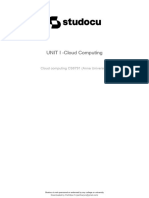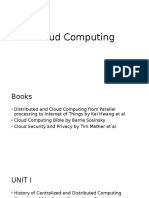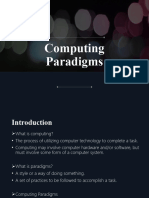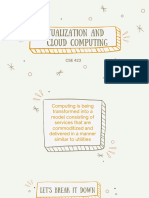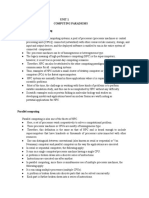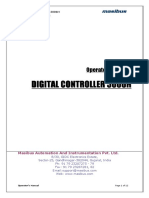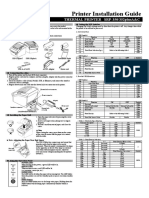Lecture One
Introduction to the Course and to Cloud Computing
ODM&C Introduction
�Introduction and course overview
What is the Cloud
Virtualization and Containers
What is the Cloud Computing architecture and service model
Data Management in the Cloud
Cloud Security and economy
...and examples based on public clouds and scientific use cases.
ODM&C Introduction
�Cloud Computing: an historical view
Cloud Computing concept is the result of the evolution of the computing
concept driven by the technology improvements and by users
requirements.
Cloud Computing
HPC HTC
Utility computing
Grid Computing Cluster computing
Distributed computing
Centralized Computing (mainframe)
ODM&C Introduction
�What is computing
“Computing is the process of using computer technology to complete
a given goal-oriented task. [...] Computing may encompass the design
and development of software and hardware systems for a broad
range of purposes”
(Association of Computing Machinery, 2005)
ODM&C Introduction
�Computing as a “numerical laboratory”
Each scientific instrument is critically dependent on computing for
sensor control, data processing, international collaboration, and
access.
Computational modeling and data analytics are applicable to all
areas of science and engineering
Capture and analyze the torrent of experimental data being
produced by a new generation of scientific instruments
ODM&C Introduction
�Distributed Computing
From a single computer to a “network” of collaborating systems.
“A distributed system is a collection of autonomous computers that are
interconnected with each other and cooperate, thereby sharing resources such as
printers and databases” (C. Leopold)
We first introduce the role of the network as a glue of multiple resources
ODM&C Introduction
�Distributed Computing Motivations
Some applications are inherently distributed problems (they are solved
most easily using the means of distributed computing)
Computing intensive problems where communications is limited (High
Throughput Computing)
Data Intensive problems: computing task deal with a large amount or large
size of data.
Distributed computing allows for “scavenging.” By integrating the computers
into a distributed system, the excess computing power can be made available
to other users or applications (e.g. Condor)
Robustness: no single point of failure.
more….
ODM&C Introduction
�Distributed computing properties
Fault tolerance
if a node fails the whole system still work
each node play a partial role (partial inputs and outputs)
check node status
Resource sharing
Load Sharing and balance
to distribute computing on different nodes to share loading to the whole
system
Easy to expand (scalability)
Improve performance
ODM&C Introduction
� Distributed computing Architecture
“interconnect processes running on different CPUs with some sort of
communication system.”
client-server: resource
management centralized at a
server
3-Tier architecture: move the
client intelligence to a middle tier
to simplify application
development.
Peer-to-Peer: responsibilities are
uniformly divided among all
machines, known as peers that
serves both as client and servers
ODM&C Introduction
�Distributed Applications
“A distributed application is software that is executed or run on multiple
computers within a network. These applications interact in order to
achieve a specific goal or task.”
ODM&C Introduction
�Examples of Distributed Systems
SETI@Home, Folding@Home…
Peer-to-Peer networks
High Availability Systems
Distributed databases
High Throughput Computing
Parallel Computing
...even the World Wide Web is a distributed system.
ODM&C Introduction
�BigData distributed computing and Hadoop
Apache Hadoop system implements a MapReduce model for data
analytics
A distributed file system (HDFS) manages large numbers of large files,
distributed (with block replication) across the storage of multiple resources
Tools for high-level programming model for the two-phase MapReduce
model (e.g. PIG)
Can be coupled with streaming data (Storm and Flume), graph (Giraph),
and relational data (Sqoop) support, tools (such as Mahout) for
classification, recommendation, and prediction via supervised and
unsupervised learning.
ODM&C Introduction
� Example of MapReduce
https://www.guru99.com/introduction-to-mapreduce.html
ODM&C Introduction
�Distributed applications in Astronomy using
Hadoop
Hierarchical Equal Area iso-Latitude Pixelization (HEALPix).
ODM&C Introduction
�ODM&C Introduction
�ODM&C Introduction
�Cluster Computing and HPC
A computer cluster is a group of linked computers, working together
closely so that in many respects they form a single computer. The
components of a cluster are commonly, but not always, connected to each
other through fast local area networks.
Clusters are usually deployed to improve performance and/or
availability over that provided by a single computer, while typically being
much more cost-effective than single computers of comparable speed or
availability.
ODM&C Introduction
�Cluster Classification
ODM&C Introduction
�HPC clusters components
Login node
Controller node
Computing Nodes
Parallel filesystem
System software
ODM&C Introduction
�Benefit of HPC clusters
Cost-effective
Much cheaper than a super-computer with the same amount of
computing power!
When the supercomputer crashes, everything crashes, when a
single/few nodes in HPC fail, cluster continues to function.
Highly scalable
Multi-user shared environment: not everyone needs all the computing
power all the time.
higher utilization: can accommodate variety of workloads (#CPUs,
memory etc), at the same time.
Can be expanded, partitioned or shrunk, as needed.
ODM&C Introduction
�HPC clusters today
HPC clusters are heterogeneous environments where the computing
power is given by CPU and Accelerators
FUGAKU - 48 cores Armv8.2
2.2GHz System, Tofu
Interconnect, 158976 nodes,
7299072 cores, 415530 TFlop/s
ODM&C Introduction
�High Performance Data Analysis
The ability of increasingly powerful HPC systems to run data-intensive
problems at larger scale, at higher resolution, and with more elements (e.g.,
inclusion of the carbon cycle in climate ensemble models)
The proliferation of larger, more complex scientific instruments and sensor
networks, from "smart" power grids to the Large Hadron Collider and Square
Kilometer Array.
The growth of stochastic modeling, parametric modeling and other iterative
problem-solving methods, whose cumulative results produce large data volumes.
The availability of newer advanced analytics methods and tools:
MapReduce/Hadoop, graph analytics (NVIDIA IndeX), semantic analysis,
knowledge discovery algorithms (IBM Watson), COMPS and pyCOMS, and more
The escalating need to perform advanced analytics in near-real time a need that
is causing a new wave of commercial firms to adopt HPC for the first time
ODM&C Introduction
�HPC Clusters usage
Complexity. HPC technology allows scientist to aim more complex,
intelligent questions at their data infrastructures.
Time to value. Science faces ever-shortening innovation and production
cycles. Analytics (including Hadoop and Spark) is moving from batch
processing toward low-latency, interactive capabilities.
Variability. “deep” vs “Wide”
“large amount of data” vs “many variables”
ODM&C Introduction
�How to use a cluster
Batch systems: a job is executed via a scheduler that optimize the
use of cluster resources
Applications must be executed using a shell script to load the proper
application environment (libraries, paths, tools)
Not suitable for interactive jobs (not completely true we can use so
tricks to make it works)
Batch is organized in queue with a limited computing time (application
snapshot and restart capabilities)
Complex filesystem structure: home, scratch, data
ODM&C Introduction
�Grid Computing
“a single seamless computational environment in which cycles, communication,
and data are shared, and in which the workstation across the continent is no less
than one down the hall"
“wide-area environment that transparently consists of workstations, personal
computers, graphic rendering engines, supercomputers and non-traditional
devices: e.g., TVs, toasters, etc."
“[framework for] flexible, secure, coordinated resource sharing among dynamic
collections of individuals, institutions, and resources"
“collection of geographically separated resources (people, computers,
instruments, databases) connected by a high speed network [...distinguished by...]
a software layer, often called middleware, which transforms a collection of
independent resources into a single, coherent, virtual machine”
ODM&C Introduction
�Why do we need Grid computing?
Going further in scientific knowledge
New high sensitivity sensors and instruments
Globally distributed collaborations
Delocalized knowledge
Scientific and technical knowledge is “distributed”
Laboratories are distributed
Scientific data are distributed
Exploiting under utilized resources.
ODM&C Introduction
�Virtual Organizations
ODM&C Introduction
�Grid Concepts
ODM&C Introduction
�Grid Middleware
It’s the software layer that glue all the resources
Everything that lies between the OS and the application
ODM&C Introduction
�Examples of Grid Computing
Globus alliance (Globus Toolkit)
gLite (EGEE middleware)
Unicore (DE)
GridBus
GRIA
LHC data has been distributed on a tiered architecture based on LHC
Computational Grid (gLite) and processed using the LHC Grid.
ODM&C Introduction
�Grid Limitations
Very Rigid environment: all the resources must be installed,
maintained and monitored homogeneously.
Useful for applications that requires an HTC environment, but a high
level of complexity is introduced to use it efficiently
Licensing problems across different domains
Implementation limits due to the middleware used.
Political challenges associated to resource sharing
ODM&C Introduction
�Utility Computing
It is a theoretical concept, and CC implements this concept in practice
“It is a service provisioning model in which a service provider makes
computing resources and infrastructure available to customers and
charges them for specific usage rather than a flat rate” (on-demand)
Low or no initial cost to get a resource (the resource is essentially
rented)
Pay-per-use model
maximize the efficient use of resources minimizing costs
ODM&C Introduction
�Main Concept of Utility Computing
1. Pay-per-use Pricing Business Model
2. Optimize resource utilization
3. Outsourcing
4. “infinite resource availability”
5. Access to applications or libraries
6. Automation
ODM&C Introduction
�Utility Computing
The principle of utility computing is very simple: One company pays
another company for servicing. The services include software rental, data
storage space, use of applications or access to computer processing
power. It all depends on what the client wants and what the company can
offer.
ODM&C Introduction
�Utility Computing in practice
Data backup,
Data Security
Partners competences
Defining a SLA
Getting Value from charge back
ODM&C Introduction
�Computing evolution
ODM&C Introduction
�End of lecture 1
Next time we will see the basic of CC and CC architecture.
ODM&C Introduction
















